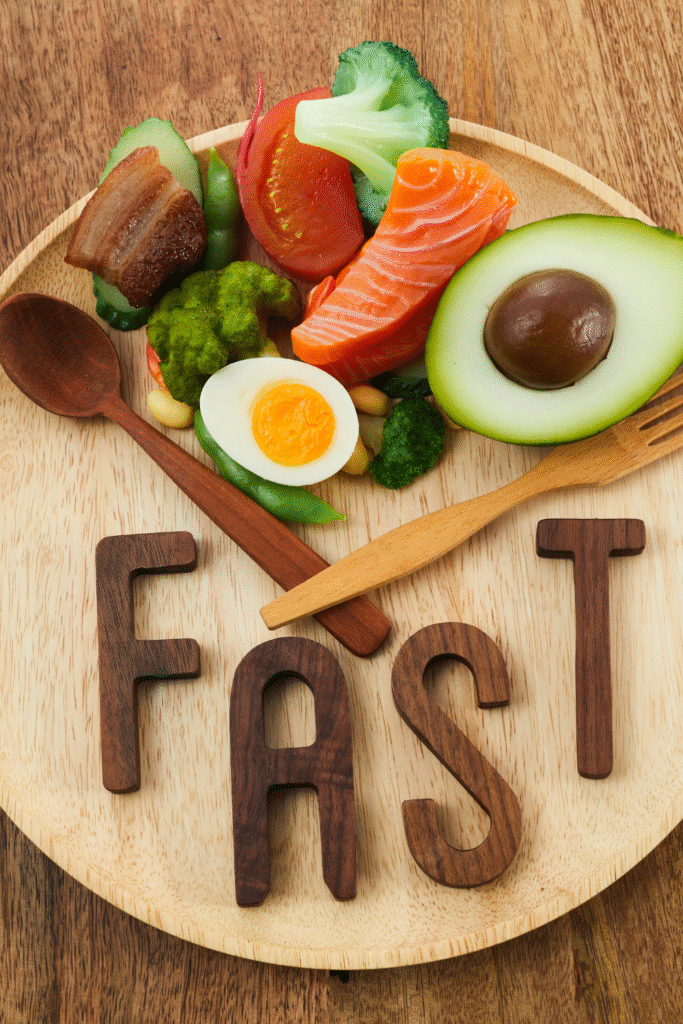Intermittent fasting has become one of the most popular wellness trends in recent years, thanks to its reported health benefits and simplicity.
With claims ranging from weight management to improved metabolic health, it’s no wonder more people are exploring this eating pattern. But what exactly is intermittent fasting, and how can you get started safely and effectively?
This beginner-friendly guide will walk you through everything you need to know, from understanding the basics to avoiding common mistakes.
By the end, you’ll feel confident to take the first step toward a healthier lifestyle.

Understanding Intermittent Fasting
What Is Intermittent Fasting?
Intermittent fasting (IF) is not a diet, but rather an eating schedule. It alternates between periods of eating and fasting. Unlike traditional diets that focus on what you eat, intermittent fasting focuses on when you eat. By limiting the hours during which you consume food, your body can spend more time burning fat and improving overall metabolic health.
How Does It Work?
The idea behind intermittent fasting is simple. When you eat, your body breaks down food into glucose, which is then used for energy. However, during fasting periods, your glucose reserves are depleted, and your body shifts to using stored fat for energy. This process, called metabolic switching, is what makes fasting so effective for fat burning and energy regulation.
Who Should Try Intermittent Fasting?
Intermittent fasting can be tailored to fit various lifestyles, making it suitable for a wide range of people. However, it’s important to consult a healthcare professional before starting, especially if you:
- Are pregnant or breastfeeding
- Have diabetes or other medical conditions
- Take medications requiring specific meal timings

Different Types of Intermittent Fasting
There’s no one-size-fits-all approach to intermittent fasting. Here are some popular methods to consider:
16/8 Method (Time-Restricted Eating)
The 16/8 method involves fasting for 16 hours and eating within an 8-hour window. For example, you might eat from 12 PM to 8 PM and fast for the rest of the time. This is one of the most beginner-friendly methods and easily fits into most lifestyles.
5/2 Method
With the 5/2 method, you eat normally for five days of the week and significantly reduce your calorie intake (around 500–600 calories per day) on the other two days. This method provides flexibility while still promoting calorie reduction.
Eat-Stop-Eat
This approach involves fasting for a full 24 hours once or twice a week. For instance, you might stop eating after dinner one day and resume eating at dinner the next day. While effective, this method may be challenging for beginners.
Alternate-Day Fasting
This involves alternating between fasting days and normal eating days. On fasting days, some people consume no food, while others allow a small intake of around 500 calories.
Warrior Diet
With the Warrior Diet, you fast for 20 hours and eat one large meal in a 4-hour window at night. This method is more restrictive and typically geared toward advanced fasters.

Benefits of Intermittent Fasting
Intermittent fasting offers several evidence-based health benefits. Here are some of the most compelling reasons to consider it:
Weight Loss and Fat Burning
By restricting your eating window, intermittent fasting helps reduce total calorie intake. Combined with metabolic switching, this makes it a powerful tool for shedding fat and managing weight.
Improved Insulin Sensitivity
Intermittent fasting can lower blood sugar levels and increase insulin sensitivity, reducing the risk of type 2 diabetes.
Enhanced Brain Health
Fasting is linked to increased production of brain-derived neurotrophic factor (BDNF), which supports brain function and may reduce the risk of neurodegenerative diseases such as Alzheimer’s.
Cellular Repair and Longevity
During fasting, your body initiates cellular repair processes, such as autophagy, where it removes damaged cells and regenerates new ones. This helps delay aging and promotes longevity.
Heart Health
Studies show that intermittent fasting can improve cholesterol levels, blood pressure, and other markers of cardiovascular health.

How to Prepare for Intermittent Fasting
Transitioning to intermittent fasting is a big step, but proper preparation can make the process smoother:
1. Set Clear Goals
Why do you want to start fasting? Whether it’s to lose weight, improve energy levels, or enhance overall health, having a clear goal will keep you motivated.
2. Choose the Right Method
Select a fasting method that suits your lifestyle and work schedule. Beginners often find the 16/8 method easiest to start with.
3. Stock Up on Healthy Foods
Prepare for your eating windows by filling your kitchen with nutritious, whole foods like fruits, vegetables, lean protein, and healthy fats. Avoid processed foods and sugary snacks.
4. Stay Hydrated
Hydration is crucial, especially during fasting periods. Water, herbal tea, and black coffee are excellent choices to keep you hydrated without breaking your fast.
5. Ease into It
If fasting sounds daunting, ease into it gradually. Start by reducing your meals to fewer hours in the day before committing fully to a fasting schedule.

Food Chart for Fasting-Friendly Options
Here’s a simple food chart to guide you in choosing the best options during eating windows:
| Food Category | Examples | Benefits |
|---|---|---|
| Fruits | Berries, apples, oranges, bananas | Rich in vitamins, fiber, and natural sugars for energy |
| Vegetables | Spinach, broccoli, kale, zucchini, carrots | Packed with nutrients, fiber, and low in calories |
| Proteins | Chicken, turkey, eggs, tofu, salmon | Helps maintain muscle mass and keeps you full longer |
| Whole Grains | Quinoa, brown rice, oats, whole-grain bread | Provides sustained energy and supports digestion |
| Healthy Fats | Avocado, nuts, seeds, olive oil, coconut oil | Essential for brain health and energy |
| Beverages | Water, herbal tea, black coffee | Keeps you hydrated and supports metabolism |
Use this chart as a guide to ensure you’re nourishing your body with balanced nutrients, even within the constraints of a fasting routine.

Tips for Success
Starting intermittent fasting can feel challenging at first, but these tips will help you stay on track and maximize results:
1. Listen to Your Body
Pay attention to hunger cues and energy levels. If you feel weak or dizzy, consider breaking your fast, and try again later.
2. Avoid Overeating
During your eating window, resist the urge to binge eat. Focus on balanced meals to support your energy needs.
3. Stay Busy
Distraction is a great way to curb hunger during fasting. Engage in hobbies, work, or light exercise to keep your mind off food.
4. Plan Social Events Strategically
Eating out with friends? Plan your fasting schedule to align with social gatherings so you can enjoy meals without breaking your fast.
5. Prioritize Sleep
Lack of sleep can sabotage your fasting efforts by increasing hunger hormones. Aim for 7–9 hours of quality sleep each night.

Common Mistakes to Avoid
Even with the best intentions, beginners often make mistakes that can derail progress. Here’s what to watch out for:
1. Skipping Hydration
Dehydration often masquerades as hunger. Drink plenty of water, especially during fasting periods, to stay hydrated and suppress appetite.
2. Relying on Unhealthy Foods
Intermittent fasting isn’t an excuse to eat junk food during your eating window. Poor nutrition can undo any benefits fasting offers.
3. Being Too Rigid
Life happens! If you miss a fasting period, don’t stress. Adjust and aim to get back on track the next day.
4. Starting Too Aggressively
Jumping straight into extended fasting periods can overwhelm your body. Begin with a manageable schedule and work your way up.
5. Ignoring Medical Advice
Always consult a healthcare professional before starting intermittent fasting, especially if you have underlying health conditions.

Motivational Closing
Starting intermittent fasting is a rewarding step toward better health, but success requires patience, consistency, and self-compassion.
Take your time to find a method that works for you, and don’t be afraid to adjust along the way.
Remember, every small change counts. Whether you’re fasting for 12 or 16 hours at first, celebrate your progress and keep moving forward. You’ve got this!
Now that you’re equipped with the knowledge and tools, why not start your intermittent fasting journey today? With the right strategies, you’ll be on your way to a healthier, more energized you in no time.
We’d love to hear about your progress and success! Sharing your story not only celebrates your achievements but can also inspire others on their intermittent fasting journeys.
Feel free to reach out and tell us how intermittent fasting has made a difference in your life. Together, we can build a supportive and motivating community!
